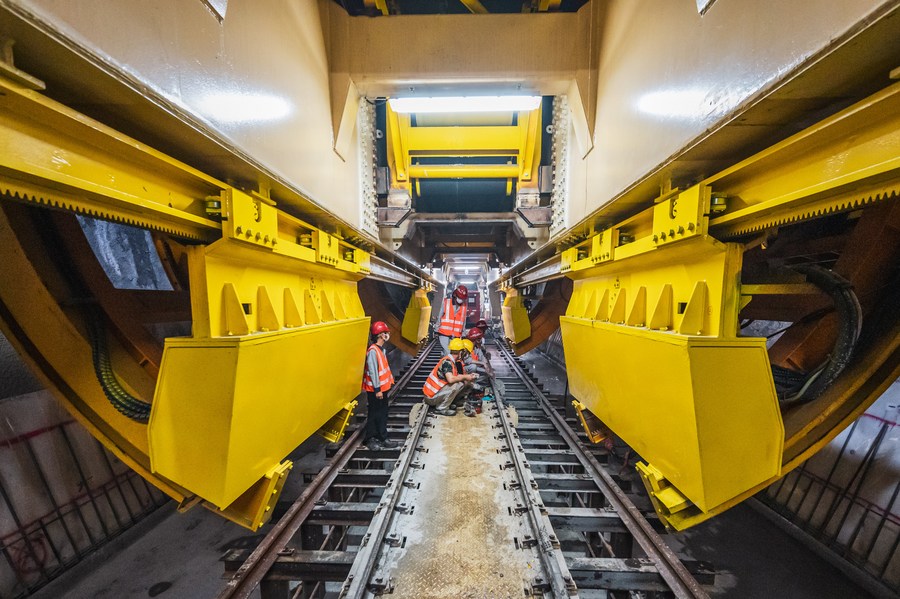
A man works at the General Tire Technology (Cambodia) factory in Sihanoukville Special Economic Zone (SSEZ) on November 21, 2023. (Photo by Liao Hongqing/Xinhua)
„The PRI has provided and will continue to provide enormous benefits to Cambodia, ASEAN and the rest of the world, contributing to building a society with a shared future for humanity,” says Cambodian scholar Thong Mengdavit.
PHNOM PENH, Dec. 23 (Xinhua) — After a decade, China's proposed Belt and Road Initiative (BRI) has injected strong momentum into socioeconomic development in the Association of Southeast Asian Nations (ASEAN), a Cambodian scholar said Friday. .
Thong Mengdavit, a research supervisor at the Asian Vision Institute, an independent think tank based in Phnom Penh, said that under the BRI, several mega-projects that receive Chinese investment or assistance have been implemented in ASEAN countries.
This aerial photo taken on Oct. 28, 2022 shows the Phnom Penh-Sihanoukville Expressway (PPSHV) in Kampong Speu Province, Cambodia. (Manual via PPSHV Expressway/Xinhua)
Those BRI projects in the region include the Sihanoukville Special Economic Zone, the Phnom Penh-Sihanoukville Expressway, and the Siem Reap-Angkor International Airport in Cambodia, the China-Laos Railway in Laos, and the Jakarta-Bandung High-Speed Rail in Indonesia. East Coast Rail Link in Malaysia, and New International Land-Sea Trade Corridor etc.
„In the ASEAN region, the BRI has played an important role in building connectivity between China and ASEAN,” he told Xinhua.
„These projects, to name a few, have contributed significantly to boosting the economy and trade in the region and have given serious impetus to ASEAN-China efforts to build a community with a shared future towards a modern and civilized humanity,” he added.
Those BRI projects have boosted trade and people-to-people exchanges between China and ASEAN, Mengdavid said, and helped attract foreign direct investment to the region.
China-Laos Railway's Lan Chang passenger train passes a maintenance center in Luang Prabang, Laos on March 30, 2023. (Photo: Zhou Xing/Xinhua)
China has been ASEAN's largest trading partner for 14 consecutive years, while ASEAN has been China's largest trading partner for three consecutive years, he said.
BRI has completed the Master Plan for ASEAN Connectivity (MPAC) 2025, he said, adding that the synergy between BRI and MPAC 2025 has greatly contributed to regional connectivity, peace and stability, economic prosperity and sustainable development.
„I can say that the BRI has contributed significantly to the promotion of peace, security, reconciliation, sustainable, inclusive growth and common prosperity in the region,” Mengdavit said.
„There is no doubt that BRI projects will continue to strengthen China-ASEAN cooperation in terms of promoting growth, reshaping the regional and global economic order, and advancing greater regionalism and integration,” he added.
This aerial photo taken on Sept. 30, 2023 shows a high-speed electric multiple unit (EMU) train of the Jakarta-Bandung high-speed railway running in Purwakarta, Indonesia. (Xinhua/Xu Qin)
The ASEAN groups are Brunei, Cambodia, Indonesia, Laos, Malaysia, Myanmar, Philippines, Singapore, Thailand and Vietnam.
The BRI, a reference to the Silk Road Economic Belt and 21st Century Maritime Silk Road, was launched by China in 2013 to build trade and infrastructure networks linking Asia to Europe and Africa and beyond the ancient Silk Road trade routes.
Over the past decade, China has signed BRI cooperation documents with more than 150 countries and more than 30 international organizations.
Speaking about the impact of BRI on Cambodia, Mengdavit said Cambodia was one of the first countries to adopt BRI, and since then the kingdom's socioeconomic progress has continued to grow and improve significantly.
Technicians work on a Chinese-made Tunnel Boring Machine (TBM) at the construction site of the Genting Tunnel of the East Coast Rail Link near Pentang in Malaysia's Pahang state on April 29, 2022. (Xinhua/Zhu Wei)
„People's living standards are rising as a result of more Chinese investment and infrastructure development and the influx of Chinese visitors,” he said. „These have greatly contributed to Cambodia's socio-economic development and poverty alleviation by creating a lot of employment opportunities for the Cambodian people.”
Mengdavit added that BRI's major projects such as hydropower plants, industrial zones, expressways, ports and airports will help Cambodia achieve its ambitious goals of becoming an upper-middle-income country by 2030 and a high-income country by 2050.
„Overall, the BRI has provided and will continue to provide tremendous benefits to Cambodia, ASEAN and the rest of the world, contributing to building a community with a shared future for humanity,” he said. ■

. „Gracz. Namiętny pionier w mediach społecznościowych. Wielokrotnie nagradzany miłośnik muzyki. Rozrabiacz”.




